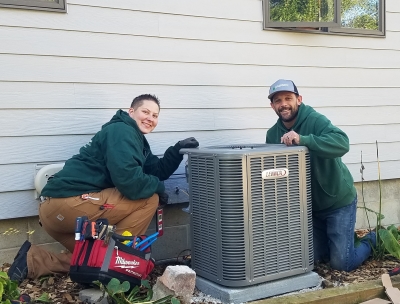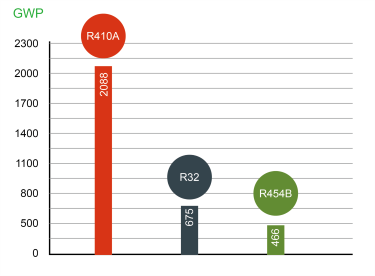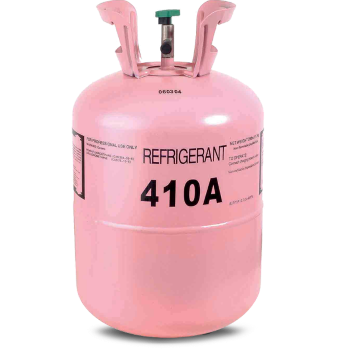
July 2024
By: Josh Walejewski
Read Time: 3 Minutes
In December 2020, the American Innovation and Manufacturing Act (AIM Act) was signed into law, ushering in new rules and regulations for HVAC equipment manufacturers. The legislation will require all newly manufactured equipment to use a new refrigerant that’s less harmful to the environment than the current R-410A refrigerant.
Let’s explore why changes are happening in 2025 and how these new regulations affect homeowners and their heating and cooling equipment.
Why is R-410A Being Phased Out?
Some homeowners might remember when the government phased out the manufacturing of R-22 refrigerant-using equipment beginning in 2010. R-410A was introduced as the refrigerant of the foreseeable future. While R-410A has a respectable Ozone Depletion Potential of 0.00 compared to R-22’s 0.06, it still has a high Global Warming Potential (GWP) of 2,090. This is where new A2L refrigerants come in.
Manufacturers around the globe have embraced two primary A2L refrigerants: R-454B and R-32. While some manufacturers have adopted R-32, industry leaders like Lennox, Carrier, Mitsubishi Electric, and Trane have chosen R-454B as their refrigerant of the future.

What is Different About the New A2L Refrigerants?
- Lower GWP (Global Warming Potential): R-454B has roughly 4.5 times less GWP than R-410A
- R-410A: GWP of 2088
- R-32: GWP of 675
- R-454B: GWP of 466
- Mildly Low Flammability:
- While A2L refrigerants are classified as mildly flammable compared to previous refrigerants, there isn’t any risk for homeowners. A2L refrigerants are extremely difficult to ignite and sustain.
- Compatibility:
- A2L refrigerants are only compatible with equipment designed for A2L types of refrigerant. For example, an older R-410A air conditioner cannot be recharged with new A2L refrigerants.
What Does This Mean for Homeowners?
Many customers have been inquiring about the new refrigerant changes. They often ask whether they should replace their HVAC equipment before the end of the year or wait until 2025 when the new refrigerant and equipment become available. This decision is particularly important for those whose systems are nearing the end of their life expectancy.
Expect Air Conditioning and Heat Pump Prices to Increase
If you see a replacement looming for your aging HVAC system in the next 2-3 years, there’s a substantial reason to avoid putting it off. With the new refrigerant requirement, all refrigerant-using equipment (air conditioners & heat pumps) is forecasted to see a price increase of 10-30%. While this might not seem like much, it adds up fast when talking about thousands of dollars.
For example, an average AC replacement today costs around $5,000-$7,000. For this scenario, we’ll say a 2.5-ton AC replacement costs $6,200. If we average the forecasted price increase range of 10-30%, that leaves us with a price increase of 20%. That $6,200 AC in 2024 may cost $7,440 in 2025.
Why Would New Refrigerants Cause Equipment Prices to Go Up?
New Technology and Design:
A2L refrigerants have different properties compared to traditional refrigerants like R-410A. This requires manufacturers to redesign HVAC systems and production facilities to accommodate these new refrigerants. This also involves research and development costs. Manufacturers often pass these costs on to consumers.
Safety, Compliance, and Liability:
As mentioned earlier, A2L refrigerants are classified as mildly flammable. As a result, it will be mandated that new systems include additional safety features. This includes improved leak detection systems, additional sensors, flame arrestors, and other safety mechanisms. All of which contribute to the increasing costs of equipment.
New Regulation Frequently Asked Questions
Will my current HVAC system need to be replaced immediately?
No, your current HVAC system using R-410A does not need to be replaced immediately. You can continue to use and service your existing system.
The new regulations apply only to newly manufactured equipment starting in 2025. However, if your system is nearing the end of its life, it would be worth considering an upgrade to avoid higher costs in the future.

If I install equipment before the new law begins, will the old R-410A refrigerant still be available? What if my HVAC system needs repairs or a recharge at some point in the future?
Parts and refrigerant for R-410A systems will still be available for many years, as the complete phase-out of R-410A production won’t occur until the 2040s.
Many contractors will continue to reclaim and reuse R-410A from older systems, ensuring a supply for maintenance and repairs.
How can I prepare for these changes as a homeowner?
Stay informed about the upcoming changes and plan for future HVAC needs. If your existing system is aging, consider budgeting for a replacement to take advantage of lower current prices. Financing can also be a great way to make the cost of a new system more manageable.
Current incentives like manufacturer rebates and state and federal tax credits can help cut down on costs significantly. Regular maintenance can also help extend the life of your existing system and ensure it operates efficiently.
Final Thoughts
If you have any questions or need guidance on the best course of action for your home and budget, feel free to contact us. We’re here to help you navigate these new changes and ensure your home remains comfortable and efficient.
Read more blog posts from Kettle Moraine Heating & AC.
About the Author
Josh Walejewski
Josh is a professional marketer who has worked in the HVAC industry since 2017. With a Bachelor of Applied Arts and Sciences Degree (B.A.A.S) in marketing and sustainable business management from the University of Wisconsin, he has a passion for all aspects of HVAC, business, marketing, and environmental stewardship.





